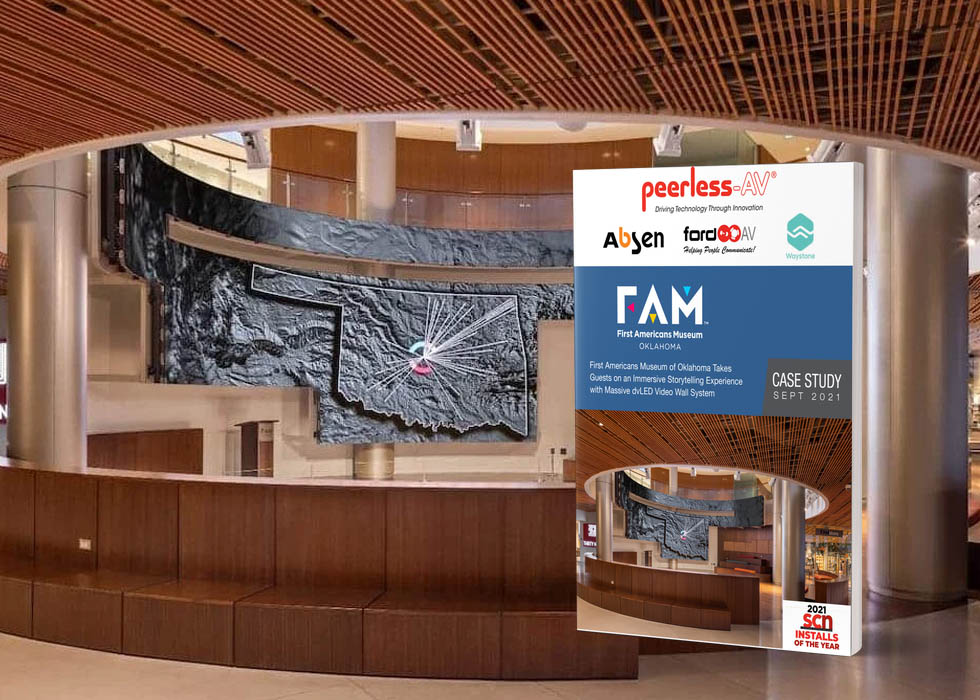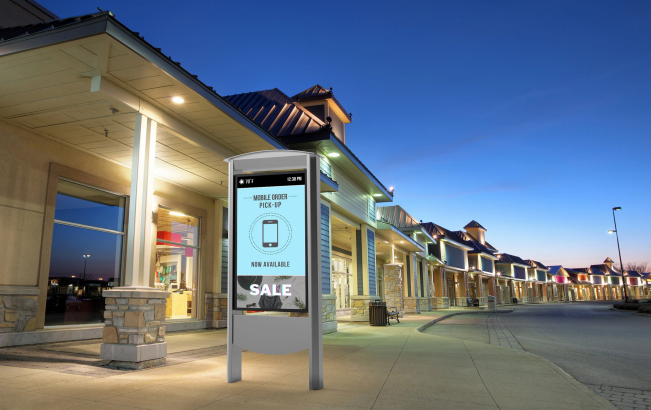Large Format Display Touchscreens Gain Interactive Signage Solution Market Share
Where Do Large-Format Displays Work – aka Go Big or Go Home!
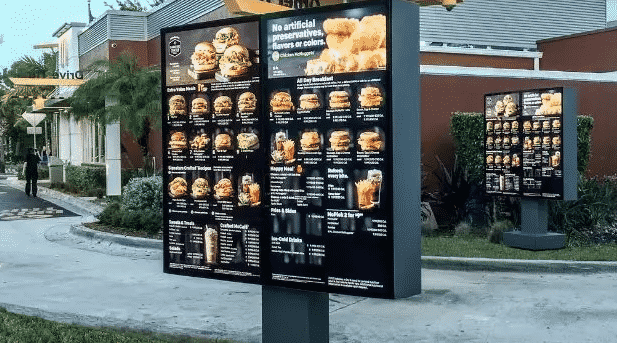 Drive Thru Keyser McDonalds
Drive Thru Keyser McDonalds
Writer: Richard Slawsky – Adjunct Professor, University of Louisville
Contributing Members: Keyser,
AcquireDigital,
LG Business Solutions, Panasonic, and Intel
Other Contributors: Barco, Sharp
NEC Display Solutions of America, Azumo, Dave Haynes/SixteenNine
In Brief
- No longer the realm of outdoor or indoor mass display, moving into corporate, banking and retail spaces
- 98 inches is the topmost “common” benchmark
- RLCD displays making inroads in outdoor (no backlight needed)
- Large displays in drive-thru and menu boards for restaurants increasing
- Fine pitch LCD becoming option of choice
Although the COVID-19 pandemic appears to be on the decline, many of the changes will be with us for the long term. An increase in the number of workers doing their jobs from home, services such as curbside pickup at retail stores, continued social distancing recommendations and contactless payment at the point of sale are among the ways of doing business that will likely be a part of our lives for the foreseeable future.
And as face-to-face interaction becomes less of a priority in the marketplace, organizations of all types are reconsidering the ways they communicate with their customers. In many cases, they’re incorporating large-format displays to accomplish the task.
“Previously, large-format displays most commonly were used for immersion and “wow factor” in experience centers or lobbies,” said John Steinhauer, vice president entertainment sales, Americas at global technology company Barco. “Now, these technologies are becoming more common for practicality in board rooms and large meeting spaces as workplaces accommodate both employee distancing rules and remote workers.”
With a trillion dollar-plus infrastructure budget being proposed by the federal government, experts say we’ll see much more digital spread through the community, not just for advertising but for information dissemination and other uses as well. Large-format displays will be at the center of those efforts.
“Since COVID seems to be on the decline, there has been a large spike in people traveling and participating in outdoor activities,” said Nick Lee, chief technology officer with global digital signage company Keyser.
“Digital doesn’t need to be the typical advertising or information,” Lee said. “It can be engaging the public. For instance, two strangers can utilize a 10′ LED pylon to play Pong for 30 seconds to win a free drink at an amusement park. They shouldn’t be treated as technology eyesores but created as artistic features that combines grace, beauty and technology into one.”
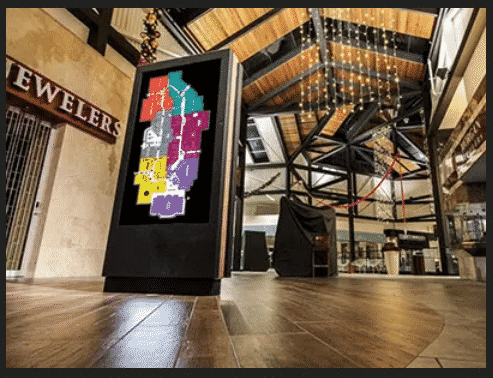 digital signage solution Keyser
digital signage solution Keyser
A Matter of Size
Twenty years ago, a 42-inch LCD display was considered massive, while today those displays are available in sizes as big as 98 inches or more. LCD displays leverage the light-modulating properties of liquid crystals combined with polarizers to create an image. The liquid crystals do not emit light directly, instead using a backlight or reflector to create an image. A resolution of 4K is becoming common, with 8k displays beginning to come down in price.
It’s unlikely displays in sizes much greater than 98 inches will be in common use, simply because of the price jump.
“You can build panels that are higher than that, but there’s going to be a very large jump in price,” said Ben Hardy, Senior Product Manager at Sharp NEC Display Solutions of America. “There are 8k 120s that are absolutely massive and beautiful, but the price jump from a 98 is at least four or five times.
In addition, there’s the difficulty in transporting such displays. A pothole on the interstate could potentially send a $10,000 display back to the factory for repairs, if not to the trash heap. Instead, a similar effect can be created via a video wall comprised of multiple 42-inch displays.
“I think large-format LCD is about as big as it will get, as the Korean and Chinese display manufacturers are not investing in billion-dollar manufacturing plants that would be necessary to make even larger LCD display mother glass,” said Dave Haynes, founder and editor of the digital signage news and information site Sixteen:Nine
Variations on the LCD concept include the organic light-emitting diode (OLED) display. Because the pixels in an OLED display emit visible light, there’s no need for a backlight. That allows OLED displays to be extremely thin, and in some cases, flexible. Although visually appealing, OLED displays are still relatively pricey compared to their LCD counterparts.
Transparent LCD displays are based on the same technology as typical LCD displays, except for the backlight being eliminated. Instead, transparent LCD displays depend on ambient lighting to create a visible image. That makes them suitable for applications such as the door of a food or drink case in a grocery store. Images on the door are made visible by the lighting in the case.
Another format making inroads is reflective LCD, or RLCD. Reflective LCD displays depend on ambient light to illuminate the image and don’t require a backlight. Because of that power consumption is low and the displays can be extremely thin. RLCD displays are a good solution for outdoor applications, although they’ll need additional lighting to be seen in the dark.
“While RLCD panels themselves may not be 84 inches for more now, you can tile them side by side to create larger displays,” said Mike Casper, co-founder and CEO of display technology company Azumo. “And the bezel is thin enough to where it won’t be noticeable from a distance.”
And making a strong showing in the large-format domain are LED displays. Such displays use the same technology behind those time-and-temperature signs that were once a feature on the side of the local bank. The difference is that pixel pitch, or the distance between individual pixels, continues to shrink, with some displays boasting a pixel pitch of 0.9 mm or even smaller. What that means is that the viewing distance, or the distance from the display the viewer needs to be to perceive a quality image, continues to fall as well. There are a variety of ways to calculate optimum viewing distance, but one common method is to multiply every 1 mm of pixel pitch by 10 to get the viewing distance in feet. So if the display features a 0.9 mm pixel pitch, viewers should be at least 9 feet away from the screen for the best effect.
Advantages of LED displays include the ability to manufacture them in virtually any shape or size. In addition, those screens can be shipped to the deployment and assembled on site. If a panel fails, it can be easily replaced. They’re much brighter than LCD displays, making them great for outdoor and/or high ambient light situations. Brightness can be easily adjusted depending on conditions.
“Large footprint video walls are already being supplanted by LED video walls, despite costs that can be three times or more the capital cost of LCD for the same physical footprint,” Haynes said. “The people who spec big video walls also like the absence of seams, longer operating life and easier maintenance.”
On the downside, LED displays can be expensive and power consumption is higher than an LCD display of comparable size, although both of those issues are being addressed as the technology improves.
First, let’s take a look at where large-format LCD displays are likely to be prominent:
Restaurants
The restaurant industry was among the hardest hit by the COVID-19 pandemic, with the National Restaurant Association estimating that more than 110,000 eating and drinking places closed either temporarily or for good in 2020.
Still, one of the restaurant verticals that fared reasonably well during the pandemic (when they could find workers) was the quick-serve segment. Thanks to existing drive-thrus, they could serve customers in a close-to-contactless manner. The challenge, though, was to speed up drive-thru service for the lack of dine-in revenue. Many accomplished that by trimming their menus, eliminating items that took longer to prepare and spotlighting higher-margin offerings.
In addition, some took the opportunity to incorporate digital menu boards at the drive-thru to speed up service. A study conducted by Atlanta-based research firm SeeLevel HX found that the use of pre-sell menu boards that display menu highlights before the customer reached the speaker cut service times at the drive-thru by an average of 13.2 seconds. Those with digital menu boards were also able to update their menus easily, avoiding the printing costs associated with static signage. The SeeLevel HX study found that those with digital menu boards reduced service times by an additional 12.3 seconds, while digital “order confirmation” boards not only increased order accuracy but sped up service times as well, by an average of 17.4 seconds. Incorporating presell boards, digital menu boards and order confirmation boards as part of a complete drive-thru solution can lower service times by as much as 42 seconds or more, critical when revenue depends on serving customers as quickly as possible.
And because the viewing distance from the customer to the board is likely to be relatively short, LCD displays will likely continue to dominate the QSR space.
Education
The pressure is on to reinstate in-person instruction, but social distancing remains a concern. One of the ways schools can address social distancing concerns while still delivering face-to-face instructions is via the use of large-format displays in lecture halls. Instructors can supplement lectures with PowerPoint presentations and/or videos, displaying those images on a screen large enough for those in the back of the hall to see clearly.
“In recent years, schools have dipped their toes into the waters of digital presentation technology—digital whiteboards, short-throw projection systems, etc.,” wrote Victoria Sanville, National Sales Manager, Public Sector Vertical at LG Business Solutions USA, in an article appearing on the education site spaces4learning.com.
“But the future isn’t about presentations; it’s not defined by teachers showing on a screen what students need to learn,” Sanville wrote. “It’s about students and teachers actively and easily engaging with what’s on a screen—manipulating it, collaborating over it, even determining what ‘it’ is.”
Modern display technology allows for this classroom engagement, Sanville wrote.
“Interactive digital boards (or Interactive whiteboards)—that is, large-format displays with integrated touch functionality—serve two important purposes,” she wrote. “Touchscreen technology allows elementary school students to interact with learning material, while boards with screen-sharing capabilities allow upper classes to see the work that a single student performs on her personal computing device—she’s able to wirelessly share what’s on her screen via the interactive whiteboard.”
Of course, cost remains a concern. Lecture halls with large-format displays may be a way to have a single professor teach in multiple locations at once. Wayfinding and sports presentations will be a factor as well.
Retail
The enclosed shopping mall is on the way out, retail industry insiders stay. A 2020 report from retail intelligence firm Coresight Research predicts that as many as 25 percent of the roughly 1,000 shopping malls in the United States will close in the next five years, with the pandemic speeding up a trend that had been gaining steam over the past decade. In the ultimate irony, many of those vacant malls are being bought up by the company that contributed to their demise: Amazon. The online retailer has converted about 25 shopping malls into fulfillment centers over the past five years.
Replacing the enclosed shopping mall is the open-air retail center. Advantages of the open-air concept compared with enclosed malls include lower operating costs, increased visibility for individual stores and a sense of increased safety when it comes to social distancing.
The challenge for store operators is to capture the attention of shoppers either from their cars or from the sidewalk. Large-format displays at the street, in windows and on sidewalk kiosks will be part of meeting that challenge.
And of course, once the customers are inside the store the same rules regarding digital signage apply. Video walls and other in-store signage will continue to deliver messaging to shoppers. More and more, though, deployers will incorporate IoT devices such as temperature sensors and Bluetooth beacons to deliver more targeted and personalized content.
Transportation and smart city efforts
Lockdowns pressed the pause button on many smart city initiatives, but they are likely to be picking up shortly. Kiosks and large-format displays are a part of those efforts. Some cities are realizing that the pandemic spotlighted the need for smart city technology.
According to a recent survey of senior officials from 167 cities across 82 countries, sponsored by technology company Oracle, 65 percent of city leaders noted the biggest lesson learned during the pandemic was just how crucial smart city programs were for their future. In addition, 37 percent of city leaders said COVID-19 highlighted the need to invest more in upgrading core infrastructure.
The pandemic highlighted several issues facing cities, including transit and mobility and Internet connectivity for digital services, teleworking and remote learning. The pandemic also shone a spotlight on the role of data and technology in delivering citizen services and making informed government decisions. And as a sense of normalcy begins to return to cities, some are incorporating technology as a way to boost efficiency.
“Pre-pandemic, cities were in relatively good shape,” Steven Goldsmith, who directs the Innovations in American Government Program at Harvard’s Kennedy School of Government, told the news site Govtech.com. “Then you wake up one day and you’ve gone from 4 percent unemployment to 20 percent unemployment. Your revenues have gone from a surplus to a really bad negative. And you’ve got a lot of ill people in your community straining your resources. These are disruptions like never before in the modern U.S. city.”
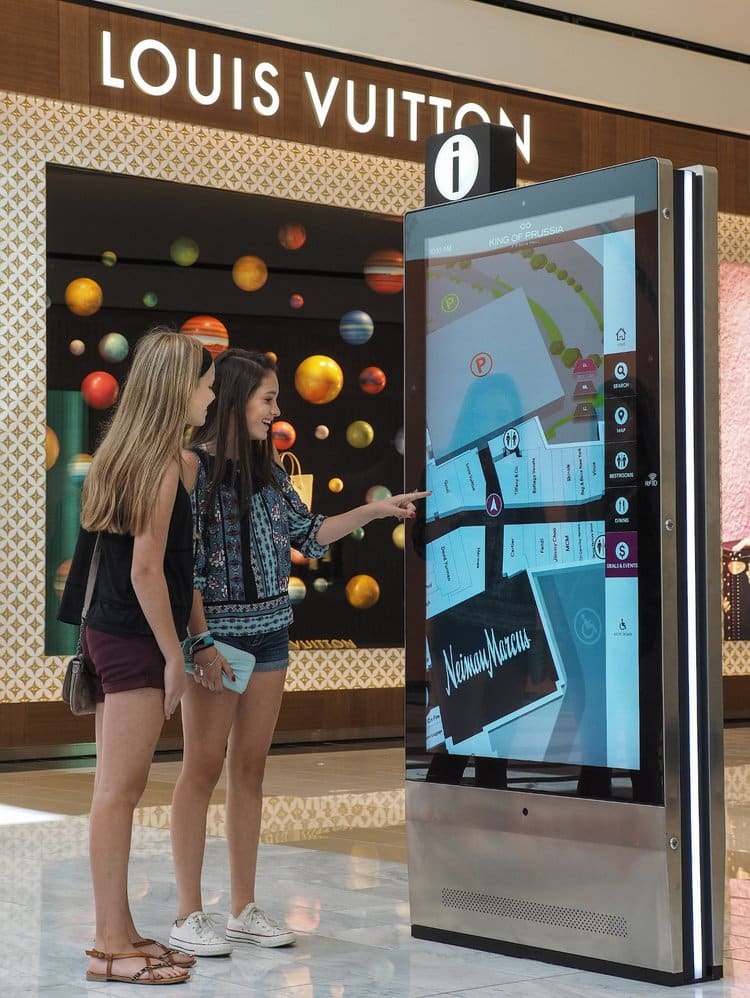 Large-format displays have long had a place in transportation, and they’ll continue to do so, albeit with some enhancements. In addition
to displaying arrival/departure information at transportation hubs, large format displays are being incorporated into ticketing and wayfinding kiosks.
Large-format displays have long had a place in transportation, and they’ll continue to do so, albeit with some enhancements. In addition
to displaying arrival/departure information at transportation hubs, large format displays are being incorporated into ticketing and wayfinding kiosks.
The Other Side of The Coin
These are some of the situations where large-format LCD displays will play a role going forward. Let's take another look at LED displays. Although fine-pitch LED has just begun to make inroads into the indoor market, it’s becoming the display of choice for outdoor applications. About 75% of the LED market is outdoor displays. Fine-pitch LEDs no longer limit the end user on the standard
16:9 aspect ratio of LCD.
“There are lots of applications for LED displays in outdoor settings such as sports stadiums, the side of buildings, digital billboards and so forth,” said Keyser president Kim Keyser-Clisham. “It’s easy to create a configuration of any size or shape.
Fine pitch LED is slowly encroaching on the large-format LCD display market, although the price point is not yet competitive with LCDs. Still, this doesn’t mean that within the next 5-10 years we won’t see significant growth in the market for indoor and outdoor LED displays.
Here’s where LED displays are likely to shine going forward:
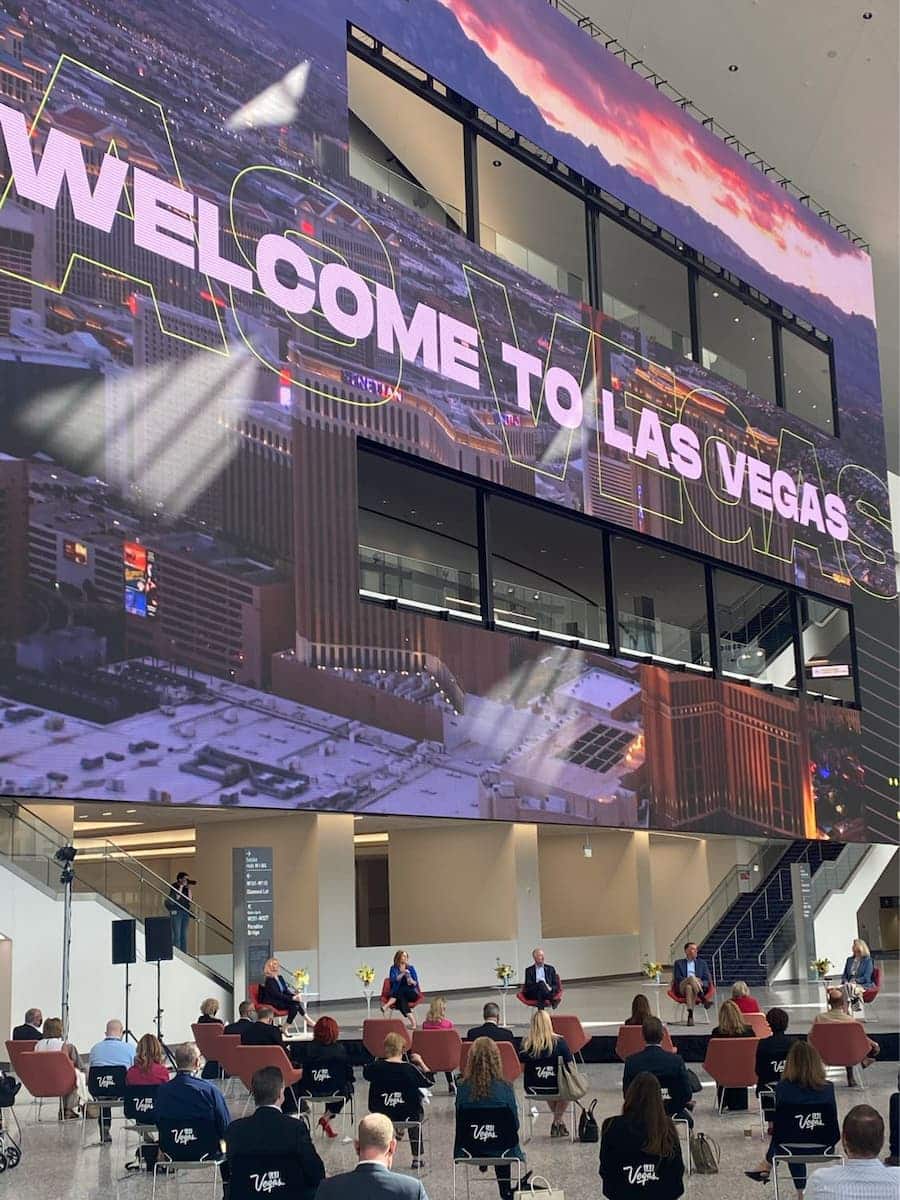 LVCC LED digital signage (22Miles software)
LVCC LED digital signage (22Miles software)
Entertainment
Large-format LED displays were playing a role in entertainment long before the pandemic. In 2014, for example, Panasonic unveiled a $12 million LED “Big Board” In Louisville, Ky., at Churchill Downs, the home of the Kentucky Derby. At the time, it was the largest 4K video board in the world at 52 meters wide and 27.5 meters tall. Content included multiple split-screen presentations of video, images, data and live and recorded programming The board offered fans in the 55,638 clubhouse and grandstand seats and the thousands of fans in the track’s 26-acre infield a clear view of the action.
Advertising
Most of us have seen LED billboards along the country’s highways and byways, and anyone who’s been to New York’s Times Square has been inundated with ads from countless LED displays.
A Place for Interactivity
Interactivity was a growing trend in digital signage before the COVID-19 pandemic, blurring the line between digital signage and self-service kiosks. But with consumers today hesitant to touch displays for fear of contracting COVID, what will be the place of interactive signage in a health-conscious world?
Many restaurants and other establishments shut down on-premises operations, during the pandemic, making the use of kiosks a moot point. But as those places reopen, the role of interactivity remains unclear.
Antimicrobial coatings for kiosks and other touchscreen displays had long been promoted as a solution for screens located in health care facilities, and interest in such solutions increased throughout 2020. Still, a report from New York-based Lux Research cautioned against making health claims regarding such coatings.
Editors Note: the most touted is antimicrobial coatings. These do not “kill” microbes, they inhibit bacteria growth once bacteria deposited. It takes time and operationally a touchscreen is repeatedly touched throughout the business cycle. The inhibit function never gets a chance. Example — If a touchscreen could go 72 hours post touch without any touching, then that original bacteria may have “starved” and died. The original recommendation to wipe down the screens periodically, if only with basic soap and water is still the best advice by far.
Antimicrobial coatings lack certainty and documentation around performance while still struggling to prove that their incorporation leads to better health outcomes, Hua said.
The Final Word
The world is slowly regaining a sense of normalcy, but it’s a safe bet that the way we interact and conduct business in the future will be much different than it was before 2020. We might be dispensing with masks and businesses may be reopening, but going forward we’ll likely be a bit more cognizant of social distancing, and many of us will be working remotely even after the pandemic is a distant memory. Organizations of all types are struggling to attract w
But to quote Albert Einstein, “In the middle of difficulty lies opportunity.” Communication will continue to be the lifeblood of the world, and while the events of the past year have been tragic, they present a tremendous opportunity for kiosks,
digital signage, and particularly, large format displays.
This article originally appeared on Kiosk Industry.



